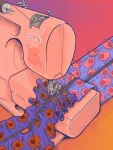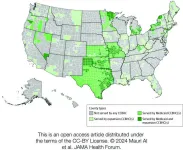(Press-News.org) A new study by researchers at the University of Arizona College of Medicine – Phoenix and the University of California Davis Health identified a new target for developing a therapy to treat atrial fibrillation, the most common type of abnormal heart rhythm.
Atrial fibrillation, commonly called AFib or AF, causes about 1 in 7 strokes, according to the U.S. Centers for Disease Control and Prevention, and is associated with a significant increase in the risk of morbidity and mortality. More than 12 million people are expected to have AFib by 2030, according to the American Heart Association, and current treatment paradigms remain inadequate, researchers say.
Proteins involved in physiological processes of the heart have been a target of research for AFib for some time. Until recently, most research suggested that treating AFib through inhibition of specific small-conductance calcium-activated potassium channels, or SK channels, could either reduce or worsen arrhythmias under different conditions.
“Our study used pioneering experimental and computational approaches to decipher how the human SK2 channel can be dynamically co-regulated. The study is especially timely considering inhibitors of SK channels are currently in clinical trials to treat AFib, making further insight into their regulatory mechanisms paramount,” said Nipavan Chiamvimonvat, MD, chair of the Department of Basic Medical Sciences at the U of A College of Medicine – Phoenix.
The paper, “Atomistic Mechanisms of the Regulation of Small Conductance Ca2+-Activated K+ channel (SK2) by PIP2,” was published in the journal Proceedings of the National Academy of Sciences.
The research team examined the role of a lipid – phosphatidylinositol 4,5-bisphosphate, or PIP2 – in regulating the SK2 channel. PIP2 is an integral component of all plant and animal cell membranes and acts as a messenger for a variety of signaling pathways in the body.
“Because PIP2 plays such an essential role in multiple ion channels, regulating cardiac ion channels through PIP2 presents a new mechanism for the lipid regulation of cardiac excitability and function,” said computational biologist Ryan Woltz, PhD, the paper’s co-first author and an assistant research professor at the College of Medicine – Phoenix.
Currently, SK channels are the only known potassium channels that are upregulated in heart failure, and their regulation plays a critical role in cardiac excitability and how disturbances in the heart’s rhythm develop.
“Since PIP2 is known to be dysregulated in heart failure, our study provides critical translational insights into possible mechanisms of cardiac arrhythmias in heart failure,” said co-first author Yang Zheng, PhD, a postdoctoral research fellow at the College of Medicine – Phoenix.
Using comparative modeling, the research team generated human SK2 channel models in closed, intermediate and open states. They then used molecular dynamics simulations to explore the molecular mechanisms of SK2 channel modulation by PIP2.
“Structural insights from our study will be useful to design novel inhibitors of SK2 channels to treat cardiac arrhythmias,” said Vladimir Yarov-Yarovoy, PhD, a professor at UC Davis Health.
Co-senior author Igor Vorobyov, PhD, an associate professor at UC Davis Health, said the team is already using similar computational approaches to study other SK channel subtypes.
“I am thrilled to participate in this collaborative multi-university and multidisciplinary research study and looking forward to a continued collaboration,” Vorobyov said. “We are currently working on applying a similar pioneering experimental/computational approach to modulation of SK channels by drug molecules, which may enhance or inhibit function of these ion channels and can be used as prospective treatment options for AFib and other cardiovascular diseases.”
A new study by researchers at the University of Arizona College of Medicine – Phoenix and the University of California Davis Health identified a new target for developing a therapy to treat atrial fibrillation, the most common type of abnormal heart rhythm.
Atrial fibrillation, commonly called AFib or AF, causes about 1 in 7 strokes, according to the U.S. Centers for Disease Control and Prevention, and is associated with a significant increase in the risk of morbidity and mortality. More than 12 million people are expected to have AFib by 2030, according to the American Heart Association, and current treatment paradigms remain inadequate, researchers say.
Proteins involved in physiological processes of the heart have been a target of research for AFib for some time. Until recently, most research suggested that treating AFib through inhibition of specific small-conductance calcium-activated potassium channels, or SK channels, could either reduce or worsen arrhythmias under different conditions.
“Our study used pioneering experimental and computational approaches to decipher how the human SK2 channel can be dynamically co-regulated. The study is especially timely considering inhibitors of SK channels are currently in clinical trials to treat AFib, making further insight into their regulatory mechanisms paramount,” said Nipavan Chiamvimonvat, MD, chair of the Department of Basic Medical Sciences at the U of A College of Medicine – Phoenix.
The paper, “Atomistic Mechanisms of the Regulation of Small Conductance Ca2+-Activated K+ channel (SK2) by PIP2,” was published in the journal Proceedings of the National Academy of Science.
The research team examined the role of a lipid – phosphatidylinositol 4,5-bisphosphate, or PIP2 – in regulating the SK2 channel. PIP2 is an integral component of all plant and animal cell membranes and acts as a messenger for a variety of signaling pathways in the body.
“Because PIP2 plays such an essential role in multiple ion channels, regulating cardiac ion channels through PIP2 presents a new mechanism for the lipid regulation of cardiac excitability and function,” said computational biologist Ryan Woltz, PhD, the paper’s co-first author and an assistant research professor at the College of Medicine – Phoenix.
Currently, SK channels are the only known potassium channels that are upregulated in heart failure, and their regulation plays a critical role in cardiac excitability and how disturbances in the heart’s rhythm develop.
“Since PIP2 is known to be dysregulated in heart failure, our study provides critical translational insights into possible mechanisms of cardiac arrhythmias in heart failure,” said co-first author Yang Zheng, PhD, a postdoctoral research fellow at the College of Medicine – Phoenix.
Using comparative modeling, the research team generated human SK2 channel models in closed, intermediate and open states. They then used molecular dynamics simulations to explore the molecular mechanisms of SK2 channel modulation by PIP2.
“Structural insights from our study will be useful to design novel inhibitors of SK2 channels to treat cardiac arrhythmias,” said Vladimir Yarov-Yarovoy, PhD, a professor at UC Davis Health.
Co-senior author Igor Vorobyov, PhD, an associate professor at UC Davis Health, said the team is already using similar computational approaches to study other SK channel subtypes.
“I am thrilled to participate in this collaborative multi-university and multidisciplinary research study and looking forward to a continued collaboration,” Vorobyov said. “We are currently working on applying a similar pioneering experimental/computational approach to modulation of SK channels by drug molecules, which may enhance or inhibit function of these ion channels and can be used as prospective treatment options for AFib and other cardiovascular diseases.”
END
New therapeutic target for cardiac arrhythmias emerges
Researchers identified a lipid that is involved in regulating cardiac ion channels, providing insights into possible mechanisms of cardiac arrhythmias in heart failure and a potential pathway for future therapeutic development.
2024-10-04
ELSE PRESS RELEASES FROM THIS DATE:
UC Irvine researchers are first to reveal role of ophthalmic acid in motor function control
2024-10-04
Irvine, Calif., Oct. 4, 2024 — A research team from the University of California, Irvine is the first to reveal that a molecule in the brain – ophthalmic acid – unexpectedly acts like a neurotransmitter similar to dopamine in regulating motor function, offering a new therapeutic target for Parkinson’s and other movement diseases.
In the study, published in the October issue of the journal Brain, researchers observed that ophthalmic acid binds to and activates calcium-sensing ...
Moffitt study unveils the role of gamma-delta T cells in cancer immunology
2024-10-04
TAMPA, Fla. (Oct. 4, 2024) — A new study published in Cell Press reveals critical insights into the role of gamma-delta T cells across 33 cancer types, shedding light on their potential as clinical biomarkers and therapeutic targets in cancer treatment. Led by a team of researchers at Moffitt Cancer Center, this comprehensive analysis represents a significant advancement in the understanding of these unique immune cells and their implications for patient outcomes in cancer therapy.
Despite their minority status within the T cell community, gamma-delta T cells are increasingly recognized for their dual capability to engage both ...
Drier winter habitat impacts songbirds’ ability to survive migration
2024-10-04
A new study from researchers at the Smithsonian’s National Zoo and Conservation Biology Institute (NZCBI) shows environmental conditions in migratory birds’ winter homes carry over to affect their ability to survive spring migration and the breeding season.
While scientists have long known that the quality of winter, or non-breeding, habitat influences migratory birds’ migration timing and reproductive success, the study, published today in Current Biology, marks the first time researchers have linked winter ...
Donors enable 445 TPDA awards to Neuroscience 2024
2024-10-04
CHICAGO – The Society for Neuroscience (SfN) is supporting 445 neuroscience trainees to attend Neuroscience 2024, SfN’s annual meeting and the world’s largest gathering of neuroscientists, through the Trainee Professional Development Award (TPDA) program. Over $560,000 in generous donations — the largest amount raised for this program — were contributed by individual donors to the Friends of SfN Fund, foundation and corporate supporters, and SfN Council. SfN Council leads this TPDA fundraising initiative and matched many of the donations.
“SfN is delighted to support ...
Gut bacteria engineered to act as tumor GPS for immunotherapies
2024-10-04
RESEARCH SUMMARY
Study Title: Nonpathogenic E. coli displaying decoy-resistant IL18 demonstrate potent anti-tumor responses and boost CAR-NK cell therapy
Publication: Nature Biotechnology
Dana-Farber Cancer Institute authors: Rizwan Romee, MD, Shaobo Yang, Michal Sheffer, PhD, David Barbie, MD, Catherine Wu, MD, Robert J. Soiffer, MD, Jerome Ritz, MD
Summary: Recent research has shown that certain forms of E. coli bacteria tend to colonize hypoxic ...
Are auditory magic tricks possible for a blind audience?
2024-10-04
Magic tricks make the impossible seem possible. Magicians have long captivated audiences with visual tricks, such as pulling a bunny from a hat or sawing someone in half, but tricks that rely on sound are scarce. A new article published in the Cell Press journal Trends in Cognitive Sciences on October 4 explores why creating a magical experience using only sound may be challenging and underscores the importance of making magic accessible to people with blindness.
"Given that magic is about the conflict between perceptual processes and our beliefs, we should be able to experience magic in ...
Research points to potential new treatment for aggressive prostate cancer subtype
2024-10-04
For more information, contact:
Nicole Fawcett, nfawcett@umich.edu
EMBARGOED for release at 11 a.m. ET Oct. 4, 2024
Research points to potential new treatment for aggressive prostate cancer subtype
In two separate papers, U-M researchers describe how a gene alteration drives prostate cancer and a potential degrader that stops it
ANN ARBOR, Michigan — When researchers at the University of Michigan Rogel Cancer Center first identified a new subtype of aggressive prostate cancer, they knew they needed to understand how this genetic alteration was driving cancer and how to target it with treatment.
In two new papers, ...
Studies examine growing US mental health safety net
2024-10-04
A decade after the establishment of the certified community behavioral health clinic (CCBHC) model, more than 60 percent of the US population has access to such facilities and the mental health and substance use disorder treatment services they provide, according to a new study led by researchers at the NYU School of Global Public Health. Moreover, these clinics are expanding the availability of crisis mental health services, including mobile crisis response teams and stabilization.
“Certified community behavioral health clinics have become a cornerstone of bipartisan strategies to increase access to and improve the ...
Social risk factor domains and preventive care services in US adults
2024-10-04
About The Study: This cross-sectional study of U.S. adults suggests that social risk factor domains were associated with decreased odds of receiving preventive services; this association was cumulative. There is a need to address social risk factors to optimize receipt of recommended preventive services.
Corresponding Author: To contact the corresponding author, Leonard E. Egede, MD, MS, email legede@buffalo.edu.
To access the embargoed study: Visit our For The Media website at ...
Online medication abortion direct-to-patient fulfillment before and after the Dobbs v Jackson decision
2024-10-04
About The Study: The findings of this study suggest that online pharmacies play an increasingly critical role in direct-to-patient medication abortion provision, especially with virtual-only platforms. These findings suggest that barriers to accessing online pharmacies for abortion care should be removed.
Corresponding Author: To contact the corresponding author, Caila Brander, MSc, email cbrander@ibisreproductivehealth.org.
To access the embargoed study: Visit our For The Media website at this link https://media.jamanetwork.com/
(doi:10.1001/jamanetworkopen.2024.34675)
Editor’s ...
LAST 30 PRESS RELEASES:
When is it time to jump? The boiling frog problem of AI use in physics education
Twitter data reveals partisan divide in understanding why pollen season's getting worse
AI is quick but risky for updating old software
Revolutionizing biosecurity: new multi-omics framework to transform invasive species management
From ancient herb to modern medicine: new review unveils the multi-targeted healing potential of Borago officinalis
Building a global scientific community: Biological Diversity Journal announces dual recruitment of Editorial Board and Youth Editorial Board members
Microbes that break down antibiotics help protect ecosystems under drug pollution
Smart biochar that remembers pollutants offers a new way to clean water and recycle biomass
Rice genes matter more than domestication in shaping plant microbiomes
Ticking time bomb: Some farmers report as many as 70 tick encounters over a 6-month period
Turning garden and crop waste into plastics
Scientists discover ‘platypus galaxies’ in the early universe
Seeing thyroid cancer in a new light: when AI meets label-free imaging in the operating room
Neutrophil-to-lymphocyte ratio may aid risk stratification in depressive disorder
2026 Seismological Society of America Annual Meeting
AI-powered ECG analysis offers promising path for early detection of chronic obstructive pulmonary disease, says Mount Sinai researchers
GIMM uncovers flaws in lab-grown heart cells and paves the way for improved treatments
Cracking the evolutionary code of sleep
Medications could help the aging brain cope with surgery, memory impairment
Back pain linked to worse sleep years later in men over 65, according to study
CDC urges ‘shared decision-making’ on some childhood vaccines; many unclear about what that means
New research finds that an ‘equal treatment’ approach to economic opportunity advertising can backfire
Researchers create shape-shifting, self-navigating microparticles
Science army mobilizes to map US soil microbiome
Researchers develop new tools to turn grain crops into biosensors
Do supervised consumption sites bring increased crime? Study suggests that’s a myth
New mass spec innovation could transform research
Maternal nativity, race, and ethnicity and infant mortality in the US
Migration-related trauma among asylum seekers exposed to the migrant protection protocols
Jupiter’s moon Europa has a seafloor that may be quiet and lifeless
[Press-News.org] New therapeutic target for cardiac arrhythmias emergesResearchers identified a lipid that is involved in regulating cardiac ion channels, providing insights into possible mechanisms of cardiac arrhythmias in heart failure and a potential pathway for future therapeutic development.


